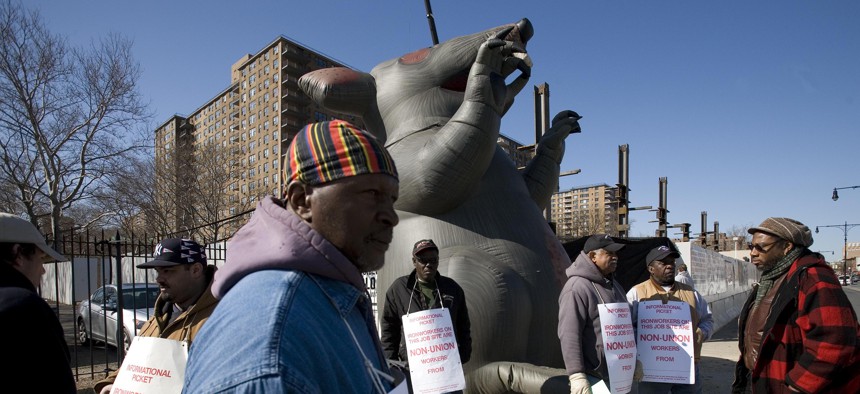Town Can Prohibit Union's Inflatable Rat Display, Appeals Court Rules

An Ironworkers union picket line featuring Scabby the Rat outside a construction site in Brooklyn, New York City in 2009. AP Photo
Grand Chute, Wisconsin didn't violate the Constitution when it ordered a union to remove "Scabby the Rat" from a road median.
The town of Grand Chute, Wisconsin did not gnaw into a labor union's right to free expression when it barred the group from placing a 12-foot-tall inflatable rat in front of a construction site nearly five years ago, a U.S. appeals court has ruled.
Construction and General Laborers’ Local Union No. 330 placed the "Scabby the Rat" figure on a road median across from a car dealership in 2014, after learning that a masonry company doing work there was paying wages and benefits that were below the union's standards.
Grand Chute is a town of about 22,600 residents, and is located roughly 25 miles southwest of Green Bay.
Details of how the case unfolded are outlined in the 13-page decision in the town's favor that was issued on Thursday, written by Chief Judge Diane Wood of the U.S. 7th Circuit Court of Appeals.
The decision partly upheld the lower court ruling in the case.
Scabby stood on at least the first day of the protest without major pushback, across from the construction site, tied-down to stakes pounded into the ground, along with a "Fat Cat" inflatable, as the union engaged in informational picketing.
But, during the week that followed, local officials told the union they would have to remove the blow-up rodent and cat because they violated a town sign ordinance. The union took down the figures.
It later filed a complaint in federal district court alleging the town was violating its First Amendment rights, discriminating against the message the rat conveyed. The inflatable rat is a common sight at labor protests, used to taunt both bosses and workers who cross picket lines.
The district court would go on to rule against the union.
Local 330 next appealed to the 7th Circuit. But the appeals court sent the case back to the district court, flagging concerns about whether it was still viable given that the construction project had been completed since the dispute over the rat and the sign ordinance began.
The lower court ruled that the case was not moot and proceeded to consider its merits.
By that time the town had approved an updated sign ordinance in 2015. The union argued that the old law violated its First Amendment rights and that the newer ordinance threatened to do so.
The appeals court decision explains that laws restricting speech in public places can be constitutional if they are "content neutral, narrowly tailored to serve a significant governmental interest" and leave "ample" other ways to communicate a desired message.
Localities can also put in place "nondiscriminatory" bans on private signs on public roadways and rights-of-way, the court noted.
A government can still run afoul of the Constitution, however, if laws along these lines are selectively enforced.
This selective enforcement concept was part of the union's argument.
It took the position that the 2014 ordinance did not place adequate limits on the town code enforcement officer's discretion about sign violations. The union also pointed to signs around the town that it suggested were out of compliance but allowed to stand.
But a town code enforcement official said he investigated the signs the union identified and took action where there were violations. The official said of 90 signs the union documented only 14 were in public rights-of-way. He ordered those in violation of the town law removed.
In court testimony, the code enforcement officer, Eric Thiel, also estimated that he had overseen the removal of about 150 signs annually from 2013 to 2015 and offered other insights into how he approached enforcement actions under the sign law.
The district court, rejecting the union's claims, ruled that the 2014 ordinance was "content neutral" and "narrowly tailored" to ban items along rights-of-way that could obstruct or distract motorists and noted that the union had other ways to communicate its message.
The appeals court affirmed this part of the district court's decision. "The Union gives us no reason to doubt the district court’s findings of fact, which we can disturb only if we find them to be clearly erroneous," Wood wrote in her decision.
"Thiel’s testimony also suffices to show that the Town’s Ordinance was not so open-ended and vague as to leave Thiel with no guidance whatsoever," the judge added.
The union said it would have used Scabby again were it not for the 2015 ordinance, which has a section with restrictions specifically targeting inflatable signs. But the district court ruled that the updated law was not unconstitutional.
Given the way the newer law is written, the appeals court decision notes there are possible questions about whether seasonal inflatables, like a pumpkin, Santa Claus, or snowman would be allowed on even private property. There was also the possibility that Scabby himself could fall under an "unwritten holiday decoration exception," Thiel said had been in effect, if a Santa hat were put on the rat.
But the appeals court determined that the district court should not have addressed the updated ordinance at all, saying the union's allegations involving it were too speculative. In light of this, the higher court vacated the part of the district court's judgement that concerns the 2015 law, sending it back to the lower court for dismissal.
Bill Lucia is a Senior Reporter for Route Fifty and is based in Olympia, Washington.
NEXT STORY: How Urban Agriculture Can Improve Food Security in Cities






